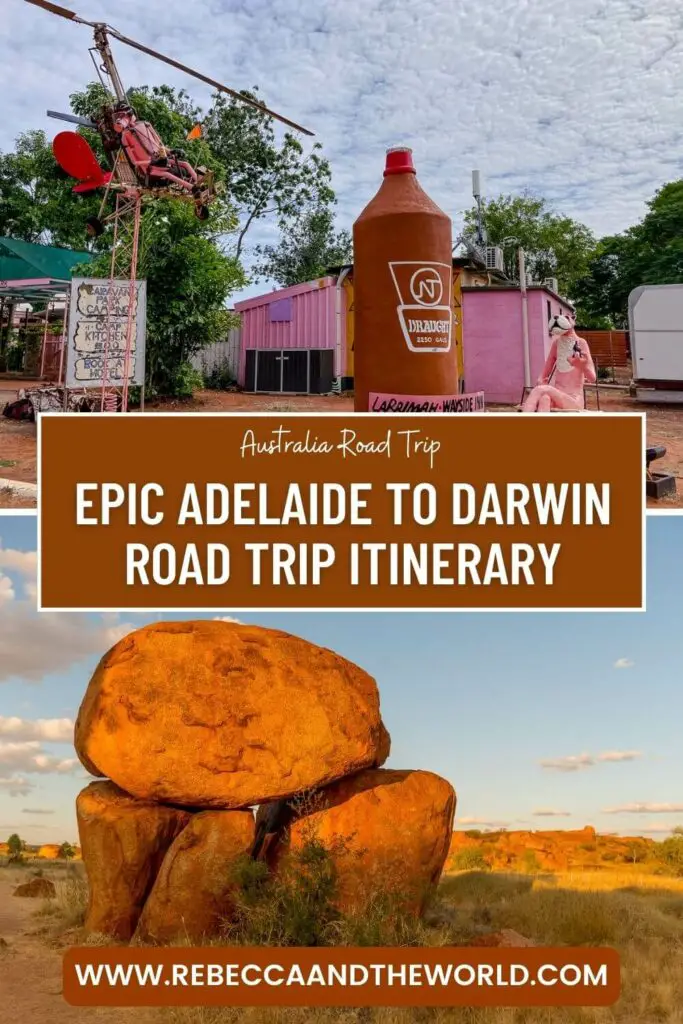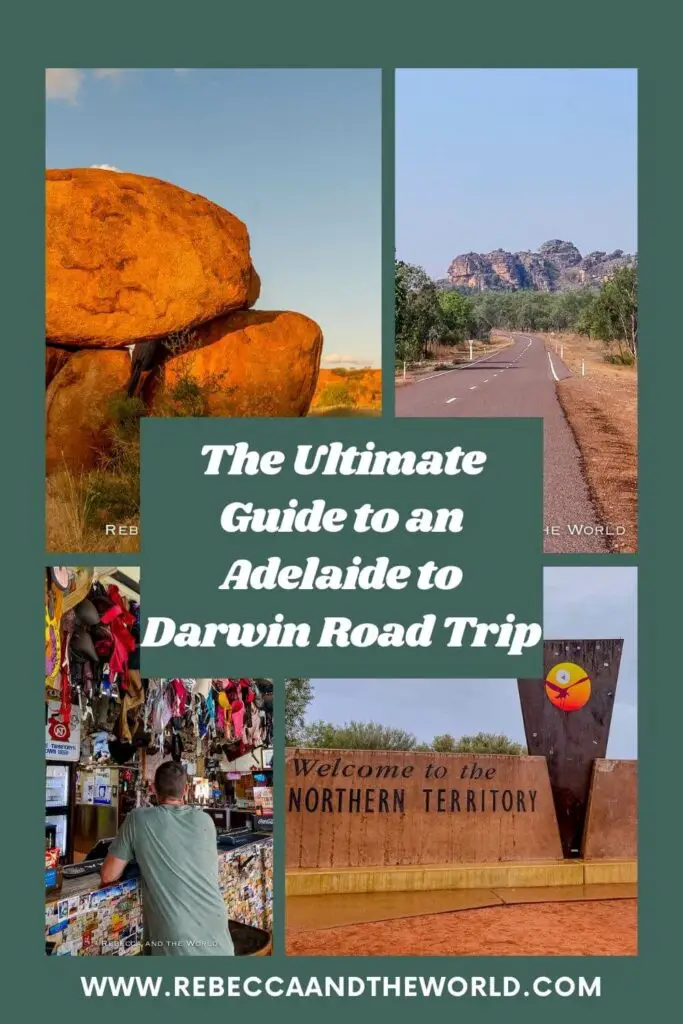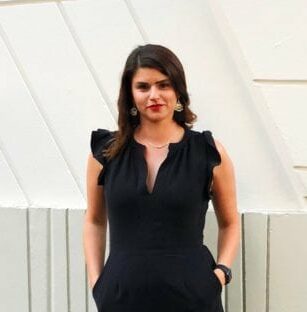Looking for an Adelaide to Darwin road trip itinerary? Here’s everything you need to know to plan one of Australia’s most epic drives!
The Stuart Highway stretches out in front of you: 3,000 kilometres of tarmac slicing through the heart of Australia, from Adelaide in the south to Darwin in the north.
This drive is a once-in-a-lifetime trip (although many end up doing it over and over again!) that will take you through quirky Outback towns, remote roadhouses and offbeat roadside stops. Not to mention side trips to some of Australia’s most stunning national parks – Uluru-Kata Tjuta, Kakadu and Litchfield, to name a few.
This is one for your Aussie bucket list and the ultimate Australian road trip. You’ll meet interesting people and be in awe of the landscapes you’ll pass through.
This guide shares everything you need to know before you hit the road, including where to stop, where to stay and what to do as you traverse Australia’s second-longest stretch of road.
So buckle up, get a really good (and long) playlist going, roll down your windows, and let’s hit the open road.
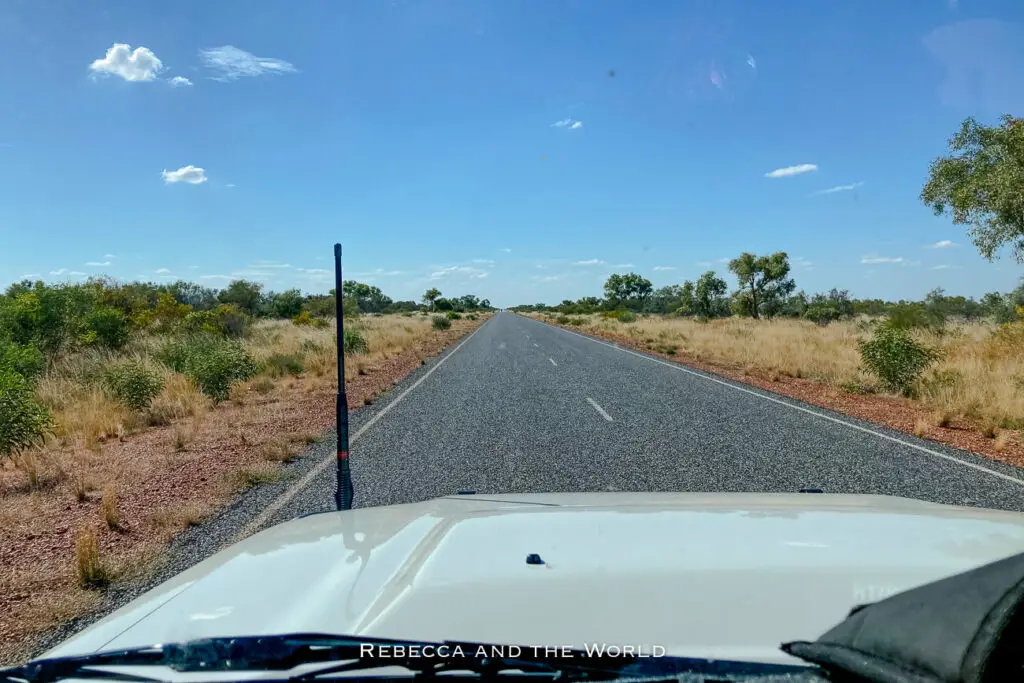
This blog post may contain affiliate links, meaning if you book or buy something through one of these links, I may earn a small commission (at no extra cost to you).
How long do you need to drive from Adelaide to Darwin?
The distance from Adelaide to Darwin is more than 3,000 kilometres! So, I recommend at least two weeks for a road trip from Adelaide to Darwin. This will allow you to take a comfortable pace and see the can’t-miss Stuart Highway attractions.
But if you have more time, even better. With three or four weeks, you can really take your time – and explore more of the lesser-known spots along the way.
Yes, you can do it quicker – but you’re going to miss a whole lot.
We did this trip in three weeks – and that didn’t include a side trip to Uluru-Kata Tjuta National Park (which we’d done on a separate trip). It also doesn’t include the week we spent ticking off all the things to do in Darwin.
This is one road trip you don’t want to rush!
Rent a campervan or motorhome! The best way to do this epic road trip is to rent a campervan or motorhome and traverse the Stuart Highway with your home on wheels. Motorhome Republic has a huge range of vehicles (along with 4WDs with rooftop tents) that you can pick up in either Adelaide or Darwin.
Adelaide to Darwin road trip itinerary
Normally in a road trip itinerary I’d include day-by-day suggestions, but instead I’ve listed the best stops so you can make this itinerary fit the time you have available. But I’ll give you a rough idea of how many days you should plan for each stop so you can map out your own schedule.
Here are the 15 key stops along this Stuart Highway road trip:
- Adelaide
- Port Augusta
- Ikara-Flinders Ranges National Park
- Coober Pedy
- Erldunda
- Uluru-Kata Tjuta National Park
- Watarrka National Park and Kings Canyon
- Alice Springs
- Karlu Karlu (Devils Marbles)
- Daly Waters
- Mataranka
- Katherine (including Nitmiluk National Park)
- Kakadu National Park
- Litchfield National Park
- Darwin
Of course, you can always do this trip in reverse from Darwin to Adelaide!
For each stop, I’ve got suggestions for things to do as well as where to stay – whether you’re camping or caravanning or need a hotel for the night.
I’ve also got some handy Stuart Highway travel tips at the bottom of this article – there are a few things you should know before you tackle this stretch of road.
Stop 1: Adelaide
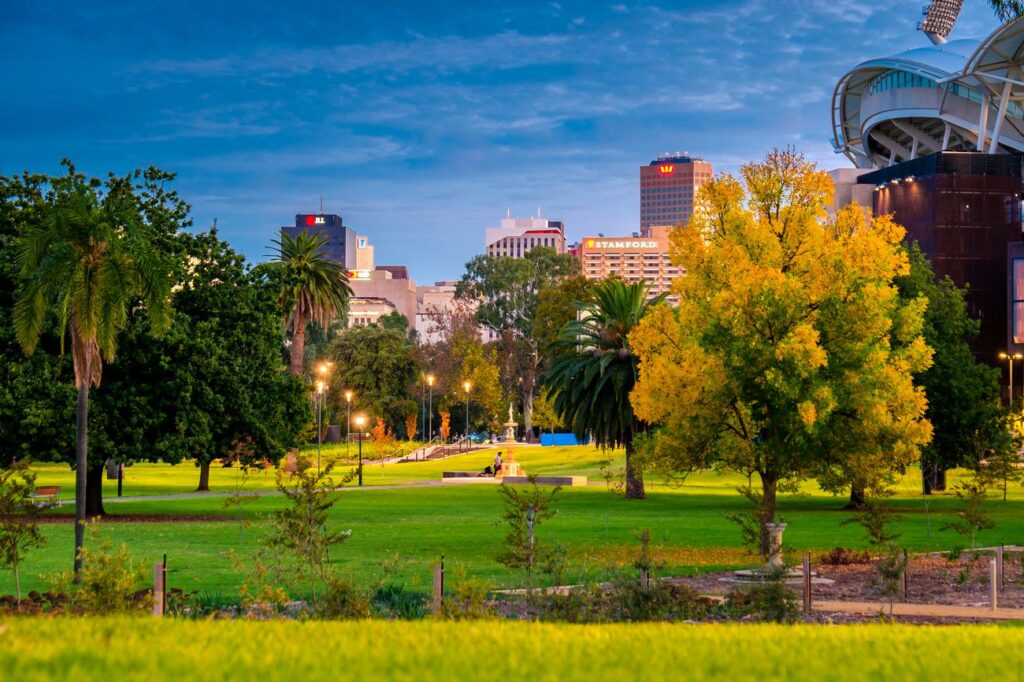
How many days here? 2-3 days
While the Stuart Highway technically begins in Port Augusta, Adelaide is a good place to start this road trip. It’s got an airport and rental car companies – as well as plenty of things to keep you busy for a few days.
Adelaide is a lovely city and easy to get around. It has a lot of green parks and doesn’t have the big-city vibe of Sydney or Melbourne, so it’s relaxed and friendly – but still has amazing restaurants and bars.
Some of my favourite things to do in Adelaide:
- Check out the Adelaide Central Market – there are some great food tours you can join here (this food tour is focused solely on the market, while this Adelaide food tour explores more of the city)
- Wander through North Terrace, admiring the heritage buildings
- Stop in at the South Australian Museum – bonus: it’s free
- Visit Hahndorf, Australia’s oldest German town (about a 30 minute drive from Adelaide)
- Hit the beachside suburb of Glenelg (there’s a tram that goes directly there from the city centre) – you might even be lucky to spot some dolphins!
- Walk or cycle along the River Torrens
Where to stay
Stay in the CBD so you’re close to everything. The Mayfair Hotel is in a beautiful heritage-listed building. Guests rave about the friendly staff and the rooftop bar. Check rates on Expedia or Booking.com
I’m a fan of the Hotel Indigo brand and their stylish rooms. The Hotel Indigo Adelaide Markets is super close the Adelaide Central Market. See availability on Booking.com and Expedia
If you’ve got your caravan or camping gear, Big4 West Beach is just a 10-minute drive north of Glenelg Beach. There are ensuite sites as well as beachfront sites. Check availability on Booking.com and Expedia
Stop 2: Port Augusta
Distance from Adelaide: 309km / 3.5 hours
How many days here? 1/2 a day
Port Augusta is the official start of the Stuart Highway. Stop here to fuel up and stock up on food and water (if you haven’t already done so in Adelaide).
We didn’t stay the night here, but if you do want to stay a little longer, you can fill your days with visits to some of the local attractions. The Wadlata Outback Centre is a great place to learn about the history and culture of the region, and the Arid Lands Botanic Garden is a beautiful spot for a picnic or stroll.
Where to stay
The Standpipe Golf Motor Inn has bright, clean rooms alongside the golf course and swimming pool. Check availability and rates on Booking.com and Expedia
For caravanners, the Port Augusta Discovery Parks is a reliable choice, with decent-sized sites, including some drive-thru sites. Check rates on Booking.com and Expedia
Stop 3: Ikara-Flinders Ranges National Park
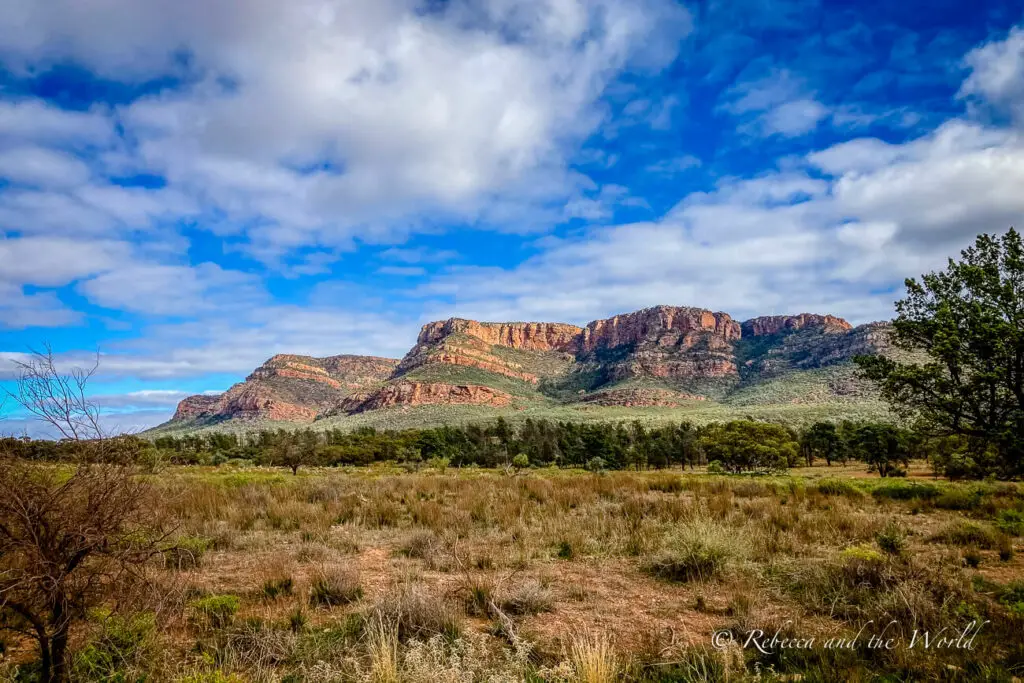
Distance from Port Augusta: 151km or 1 hr 45 mins
How many days here? 3-5 days
I highly recommend taking an optional side trip off the Stuart Highway to the stunning Ikara-Flinders Ranges National Park.
With its abundant wildlife, rugged mountain peaks and deep gorges cutting through the landscape, there’s no other place quite like it.
It’s home to Ikara (Wilpena Pound), a natural amphitheatre created by the erosion of a once-mighty mountain range. Many Aussies have never even heard of this place – but it’s actually eight times the size of Uluru and 300 metres taller, which gives you some idea of just how incredible this place is.
I have a full guide to Ikara-Flinders Ranges National Park which includes itinerary ideas.
This national park is a hiker’s dream, with trails of varying lengths and difficulty. Some of my favourite hikes are Arkaroo Rock (3.1km loop, moderate), which leads up to a rock shelter with ochre and charcoal rock art, and the Wangara Lookout trail (7km return to the upper lookout, hard), which has the best views of Ikara/Wilpena Pound.
St Mary Peak (Ngarri Mudlanha) is a 19km circuit that’s rated hard. But if you’re prepared for the challenge, you’ll be rewarded with incredible views and scenery.
As you’re hiking, keep an eye out for the elusive yellow-footed rock wallaby, Australian ringnecks, emus and other native wildlife.
There are also some great day trips from the national park to 4WD tracks that highlight the unique geology of the area. And don’t miss the charming Outback towns – Blinman is a former copper mining town, while Parachilna is home to the unexpectedly classy Prairie Hotel (try the Feral Feast!).
Where to stay
To be right in the national park, stay at Wilpena Pound Resort. It has a range of accommodation options, from camping to motel-style rooms and safari-style glamping tents. There’s a restaurant and bar, pool, and supermarket on site.
We booked a powered campsite and it was a good size with its own fire pit. The campsites are suitable for tents, camper trailers (like we had) and caravans. There’s also a spacious unpowered section. Check availability and rates online
Just outside the national park is Rawnsley Park Station, one of the oldest stations in the area. Accommodation here ranges from affordable cabins to luxurious eco-villas, as well as caravan and camping facilities. It’s dog-friendly for those travelling with pets. The station is also home to the excellent Woolshed Restaurant. Check rates online
READ NEXT: Top 13 Things to Do in Ikara-Flinders Ranges National Park (+ Itinerary Ideas!)
Optional overnight stop: Pimba
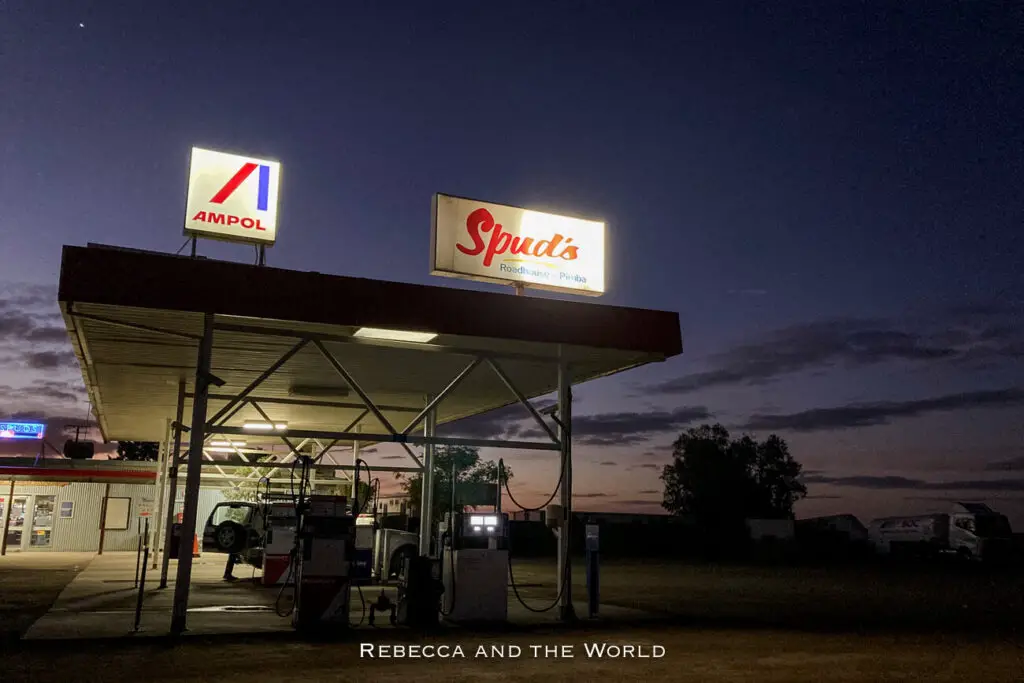
Coober Pedy is the next stop on this itinerary – but it’s a long way from Ikara-Flinders Ranges National Park or Port Augusta.
If you want to break up your trip into smaller, more manageable chunks (as we did) then Spuds Roadhouse in Pimba (174km/2 hours from Port Augusta or 322km/3.5 hours from Ikara-Flinders Ranges National Park) is a good place to spend the night.
There’s plenty of space at the roadhouse, but I recommend aiming to be there by 3pm or 4pm as it can fill up quickly. It’s $5 a night to park up and there are toilets and coin showers. The pub meals at the roadhouse are very good.
The trains and road trains are pretty noisy, though – and they go all through the night!
There are also very basic motel rooms.
While you’re in the area, check out Woomera, which was the home of Australia’s rocket testing program. There’s a free museum open daily from 9am to 5pm.
Stop 4: Coober Pedy
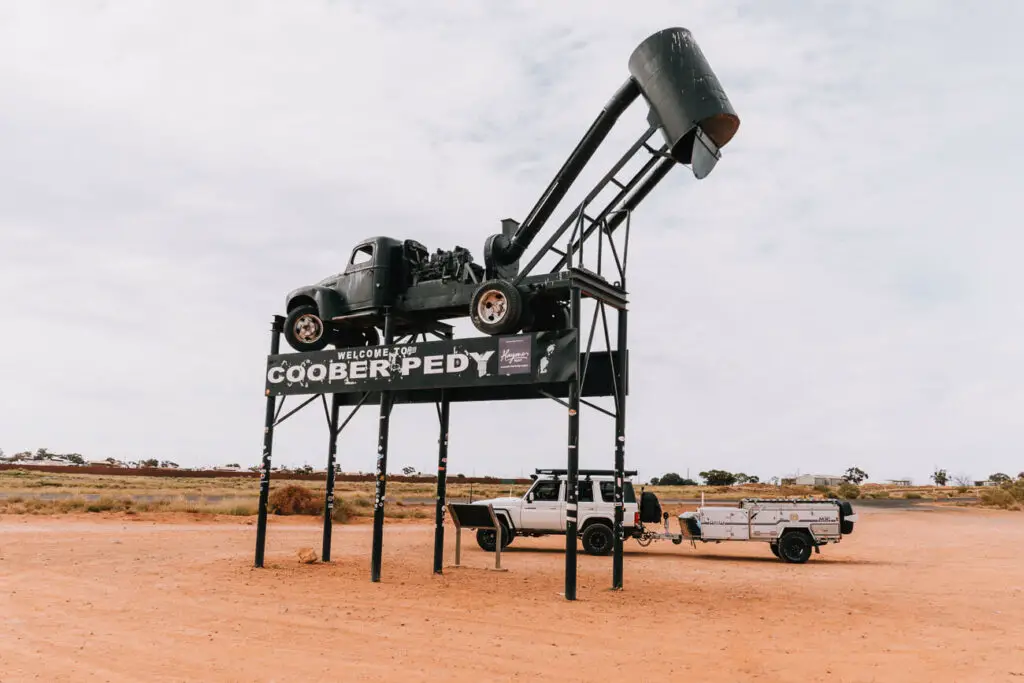
Distance from Flinders Ranges National Park: 691km or 7.5 hours
How many days here? 2-3 days
In the heart of the South Australian Outback, Coober Pedy is one of Australia’s quirkiest and most intriguing towns. It’s unlike any other place I’ve visited in Australia – or the world. You’ll either love it or you hate it – I was definitely the former.
Known as Opal City, Coober Pedy produces the largest amount of opal in the world by mass, so understandably many Coober Pedy tourist attractions focus on this. Visit the Old Timers Mine or Tom’s Working Opal Mine to learn more about opal mining and get an understanding of the conditions miners work in.
Coober Pedy can get very hot – sometimes up to 45°C during the summer months. To combat this, people have been building their homes into the hills and underground for decades to stay cool. Visit one of these underground homes to see how locals live. My favourite is Faye’s Underground House and Mine, the home of the first woman to own and operate a mine in Coober Pedy.
Of course, you can’t visit Coober Pedy without trying to find an opal yourself. Go noodling at Tom’s Working Opal Mine or in any of the public claypans around the town. Not so lucky? Then there are plenty of opal shops around town where you can buy a piece.
Where to stay
A must-do in Coober Pedy is to stay in an underground hotel. Two excellent options are:
- Desert Cave Hotel: great-sized rooms with access to the hotel’s bar and restaurant (make sure you choose an underground room as they also have aboveground rooms). Check rates online
- Comfort Inn Coober Pedy Experience: originally a working wine, the rooms in this motel have kitchenettes which are handy. Check availability and rates
For caravanners and campers, there are plenty of options. We stayed at the Big4 Stuart Range Outback Resort. There’s a mix of caravan sites and cabins at this caravan park, and a pool, BBQ facilities and playground. It is on the Stuart Highway so there can be some noise at night as the road trains go by, but it’s not too bad.
If you’re camping, stay in the world’s only underground campground at Riba’s Underground Campground. Set up your tent underground in the former mine.
READ NEXT: 25 Unique Things to Do in Coober Pedy: Australia’s Quirkiest Town
Stop 5: Erldunda
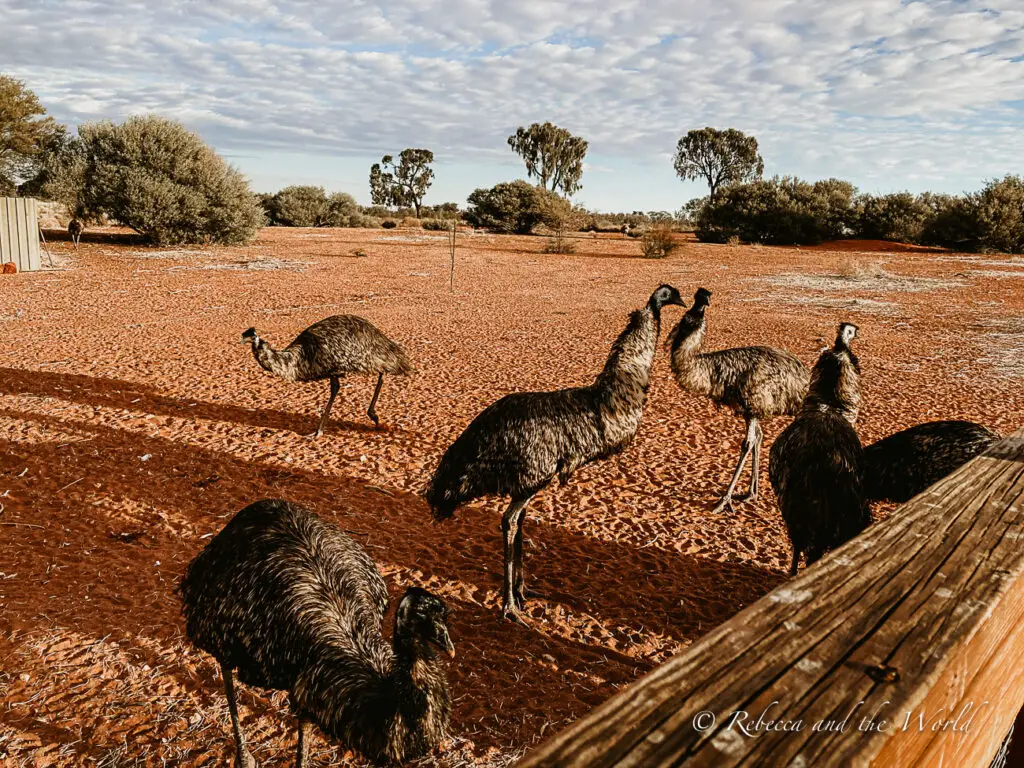
Distance from Coober Pedy: 487km or 5 hours
How many days here? Overnight stop
Coober Pedy is a long way from anywhere, so as you’re heading north, I recommend stopping at the Erldunda Roadhouse. This roadhouse sits on the turnoff to Uluru-Kata Tjuta National Park, just across the Northern Territory border – and the start of the Northern Territory road trip section.
We’ve stayed here on two separate trips. There’s a large camping area with powered and unpowered sites, as well as several motel rooms. If you need power, try to book ahead as these do fill up quickly.
There’s not a lot to do here – but consider this a great rest stop. You’ll see Carlotta, the resident camel, as well as a hungry mob of emus. The pub meals at the roadhouse are great and much-needed after a long day of driving.
Stop 6: Uluru-Kata Tjuta National Park
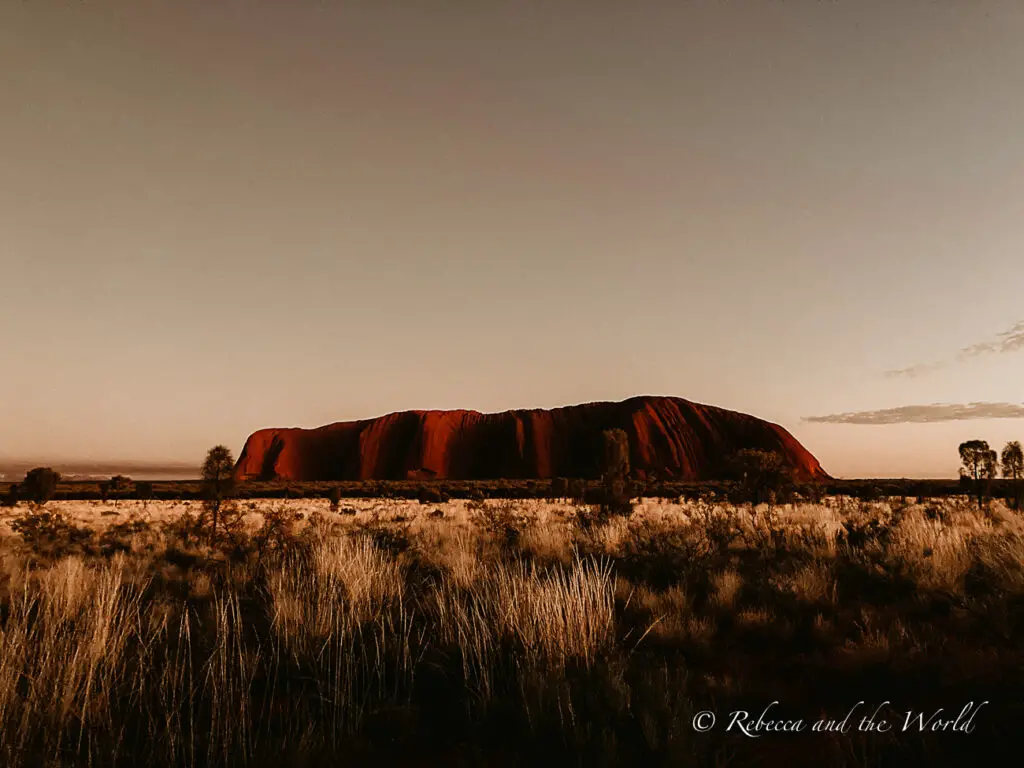
Distance from Erldunda: 247km or 2.5 hours
How many days here? 2-3 days
Iconic Uluru isn’t on the Stuart Highway but it’s certainly worth the detour. Located in Uluru-Kata Tjuta National Park, Uluru (often also called Ayers Rock) is the world’s largest monolith and one of Australia’s most famous landmarks.
Towering 348 metres above the Earth’s surface, what’s even more mind-boggling is that there’s more than 2.5 kilometres of Uluru actually beneath the surface!
This sacred site on the lands of the Anangu people has evidence of human life dating back some 30,000 years. I’ve no doubt that you’ll feel a deep sense of spirituality when you’re here.
Spend a few days at Uluru so you can see it from a few different angles. Start with a walk or bike ride around the base of Uluru, a 10.6km loop.
Plan your trip so that you have time to see Uluru at both sunrise and sunset – it looks completely different at both times of the day.
While most people focus on Uluru, just a short drive away is Kata Tjuta (also known as The Olgas), a a series of 36 domes pushing their way out of the flat surrounding land. The tallest dome rises almost 550 metres high.
Start by taking a look at the domes from the viewing platform, and then take some hikes through them. The Valley of the Winds Walk (7.4km loop) has some great lookouts, while the Walpa Gorge trail (3km) is an easier hike through the rock walls. You’ll feel very small here!
In the evenings, splurge on dinner under the stars by booking Tali Wiru or Sounds of Silence. These experiences aren’t cheap but they are incredible. I also recommend the Field of Lights or the new Wintjiri Wiru – both are stunning light shows with Uluru as a backdrop.
Where to stay
We stayed at Ayers Rock Campground, which is well-equipped with showers, washing machines and drinking water. Plus you have access to all the other facilities on offer at Ayers Rock Resort (IGA, petrol station, cafés and restaurants). Sites here book out months in advance so book ahead.
If you can’t get a spot here, Curtin Springs Station is the next nearest option (100km away from the park).
There is no camping allowed elsewhere in the park.
Ayers Rock Resort also has several hotels, including (in order of affordability): the Outback Pioneer Hotel & Lodge, The Lost Camel Hotel, Emu Walk Apartments, Desert Gardens Hotel and Sails in the Desert.
If you really want to splash out, Longitude 131° is the ultimate in luxury.
You can read my full guide to where to stay near Uluru for more info.
READ NEXT: What to Pack for Uluru
Stop 7: Watarrka National Park and Kings Canyon
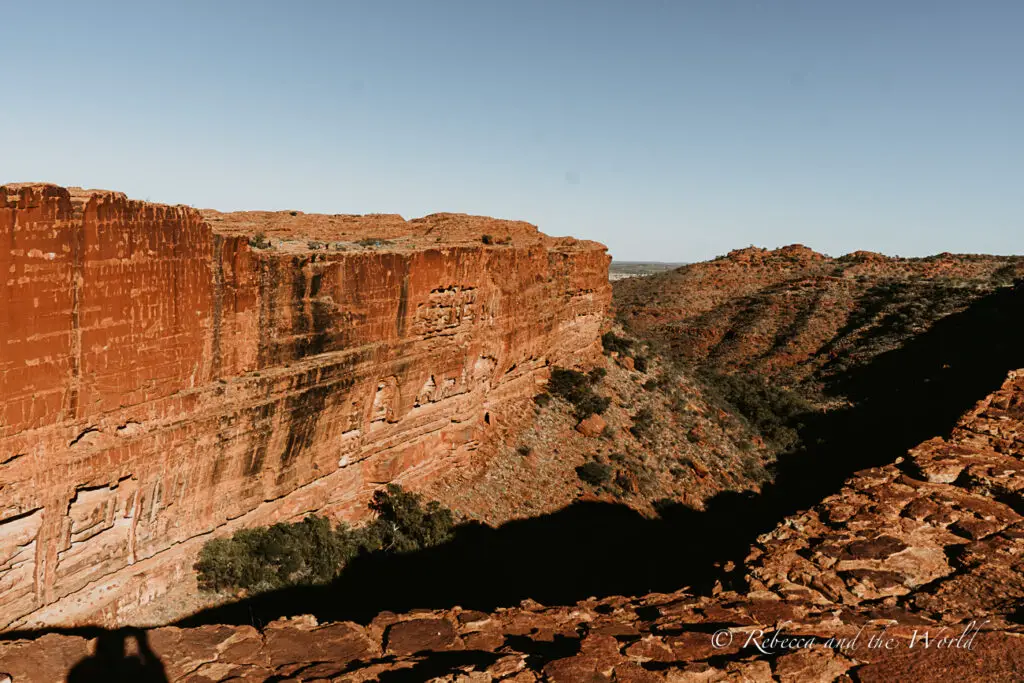
Distance from Uluru-Kata Tjuta National Park: 303km or 3 hours
How many days here? 2 nights
After experiencing the iconic Australian landmark that is Uluru, it’s time to hit the road again. The next stop on our journey brings us to Kings Canyon, one of the highlights of Watarrka National Park.
On the lands of the Luritja people, Kings Canyon is one of my favourite places in Australia. The Kings Canyon Rim Walk (6.4km loop, moderate) has magnificent views across the canyon rim. The first part of the hike is tough, involving hundreds of steep steps.
But once you’ve tackled those steps, the rest of the hike is fairly moderate. You’ll pass orange sandstone domes, through the lush Garden of Eden, into a shady pool surrounded by towering walls and around the weathered “Lost City” beehive domes.
If you want to see Kings Canyon from above – which would be amazing – you can also book a 15-minute helicopter ride.
Once you’ve done with hiking, learn about local Aboriginal culture at Karrke. The one-hour Aboriginal Cultural Tour is an immersive lesson in bush tucker, natural medicine and traditional art. Tours are just a 30-minute drive from Kings Canyon Resort, and you can book online here.
Where to stay
We stayed at Kings Canyon Resort and loved it. The powered van sites were generous in size and most are fairly shaded. There’s a deck (the Luritja Lookout) that’s perfect for watching the sunrise over Kings Canyon. Most nights there’s live music there as well as the cutest little caravan serving up drinks. Kings Canyon Resort also has rooms and glamping tents. Check rates on Expedia and Booking.com
Kings Creek Station is about a 25-minute drive from Kings Canyon carpark. This working cattle and camel station has camping, glamping and rooms available. It also has a great café onsite – where I tried their famous camel burger! Check availability online
READ NEXT: Into the Heart of Australia: A One-Week Alice Springs to Uluru Road Trip
Stop 8: Alice Springs
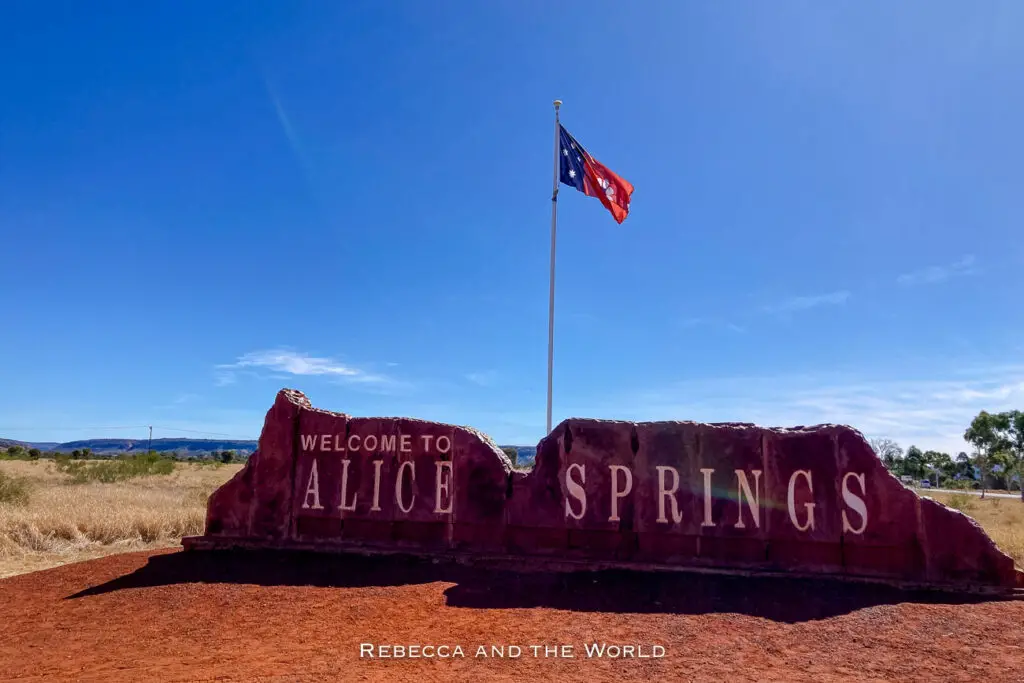
Distance from Kings Canyon: 475km or 5 hours (2WD route) or 332km or 3.5 hours (4WD route via the Mereenie Loop)
How many days here? 2-3 days
On your road trip from Adelaide to Darwin, a stop in Alice Springs is a must. While this town serves as the gateway to one of Australia’s most iconic attractions – Uluru – it’s also a fantastic destination in its own right.
Spend a day at the Alice Springs Desert Park to explore the local flora and fauna. You’ll need at least half a day here because it’s an enormous site and there are fantastic talks and demonstrations throughout the day.
Visit the Araluen Cultural Precinct, home to an Aboriginal art gallery as well as the Museum of Central Australia and the Central Australian Aviation Museum. Or wander the Olive Pink Botanic Garden.
An unmissable day trip (or you could even plan 2-3 days) is a drive out to the East or West MacDonnell Ranges – “the Macs”. The West Macs are a little more accessible. I recommend driving out to Ormiston Gorge and then making your way back to Alice via Ellery Creek Big Hole and Standley Chasm (Angkerle Atwatye). There are some great hikes at most of the stops, most of them short and fairly easy, as well as swimming holes to cool off in.
Highlights of the East Macs are Trephina Gorge, N’Dhala Gorge and Ruby Gap Nature Park. Trephina Gorge has some great hikes that are definitely worth checking out, while N’Dhala Gorge has ancient Aboriginal rock carvings – it’s one of the largest sites open to the public.
Where to stay
There are plenty of accommodation options in Alice Springs.
DoubleTree by Hilton: Luxe 4.5-star hotel with stunning views of the MacDonnell Ranges. It’s got comfy guest rooms and suites and is conveniently located close to town. Check rates online with Booking.com | Expedia
Alice on Todd Apartments: Ideal for those who want self-catering options, these apartments are well-equipped and situated by the Todd River. Check rates online with Booking.com | Expedia
YHA Alice Springs: A budget-friendly option housed in a historic outdoor movie theatre, this hostel offers clean facilities and a social atmosphere, perfect for solo travellers or groups. Check rates online with Booking.com | Expedia
Alice Springs caravan parks: As a key stop on the Stuart Highway there are plenty of caravan parks around Alice Springs. We’ve stayed at both the Alice Springs Tourist Park (quiet, opposite the Araluen Cultural Precinct) and the Alice Springs Discovery Park (lots of facilities, food trucks, pancake Sundays, movie nights). I’d recommend either for camping, caravan park sites or cabins.
READ NEXT: 15 BEST Things to Do in Alice Springs, Australia
Stop 9: Karlu Karlu-Devils Marbles
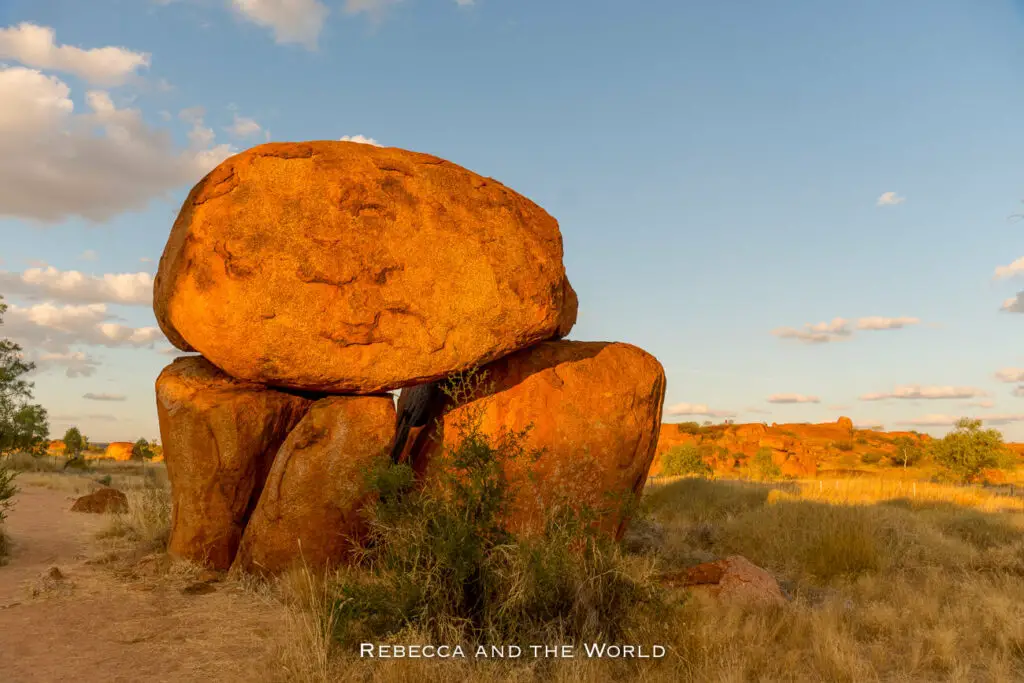
Distance from Alice Springs: 403km or 4 hours
How many days here? Overnight stop
As you leave Alice Springs and continue further north, stop at the Tropic of Capricorn marker, about 20 minutes away.
Another roadside attraction is Anmatjere Man. The Anmatjere Man is a 17-metre-high sculpture, depicting a local indigenous man with an emu on his shoulder. It’s on top of a hill that sits above the Aileron Roadhouse. The roadhouse is about 1.5 hours north of Alice.
But our stop for the night – and the main attraction up here – is Karlu Karlu (Devils Marbles). These large boulders are scattered across a wide, shallow valley and have cultural significance to the traditional owners of the land, the Warumungu, Kaytetye, Alyawarra and Warlpiri people.
The best time to visit is at sunrise or sunset when the light reflects off the boulders, creating a stunning sight. A lot of people go at sunrise, but we liked sunset – it was quieter and we didn’t have to get up so early!
Where to stay
There’s a campground at Karlu Karlu / Devils Marbles Conservation Reserve. You have to book ahead online. Only a few campsites have shade, but there are covered picnic areas.
If, like us, you can’t get a spot at the campground, the Devil’s Marbles Hotel is the next best option. Only 8 minutes’ drive from Karlu Karlu, there are cabins and caravan/camping sites. Best of all, there’s a pool and beer garden. The meals are great, too.
Top tip: there’s actually a FREE rest area in front of the Devil’s Marbles Hotel – and they let you use the hotel’s toilet and shower facilities. This is where we set up for the night (although of course you’re right on the highway with plenty of road train noise throughout the night).
Stop 10: Daly Waters
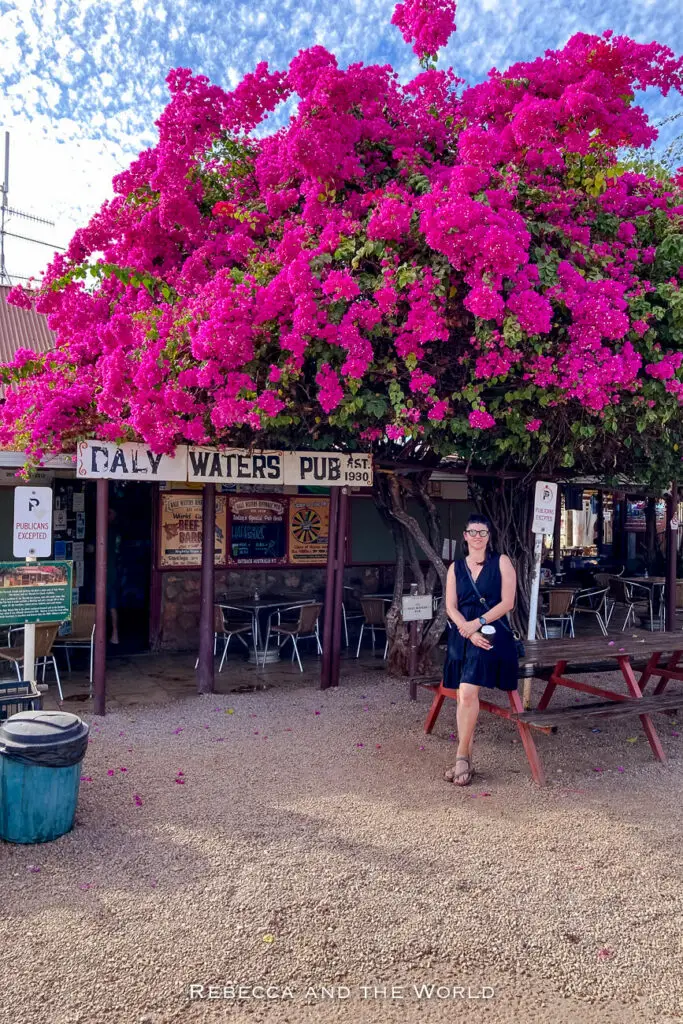
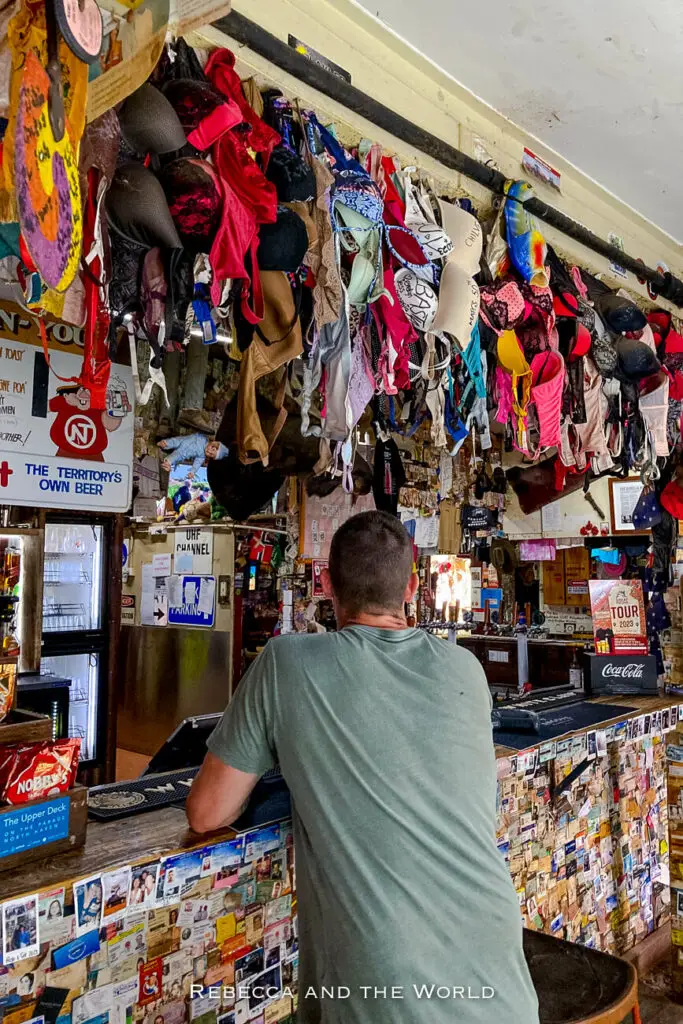
Distance from Karlu Karlu: 511km or 5.5 hours
How many days? 1-2 nights (overnight stay is fine, but spend an extra night if you need to rest up after all this driving!)
A few hundred kilometres north of Karlu Karlu is Daly Waters, a blink-and-you’ll-miss-it-town that’s famous for its pub.
The Daly Waters Pub is an offbeat stop on the Stuart Highway. This pub is as iconic as outback pubs come, serving cold beer and tasty pub meals. The walls of the pub are covered in travellers’ signatures, souvenirs and other interesting objects from across the years. Leave your bra or thongs (flip-flops) as a memento for future visitors.
Each night during the busy season, Tim, the pub’s owner, cruises down the dusty street in his motorised wheelchair (he’s a rather large man), corralling all the horses, donkeys, goats and chickens back to their pens for the night.
There’s also live music and plenty of other travellers to chat and swap travel tales with.
Opposite the pub there’s a small museum – “Tim’s Junkyard” – of all the things Tim’s collected during his lifetime.
And nearby is Stuart’s Tree, where John McDouall Stuart carved an S during his 1861 journey from Adelaide to Darwin.
Where to stay
The Daly Waters Pub owns a large swathe of land, most of which has been converted to caravan and camping grounds. I recommend arriving early or trying to book ahead to secure a spot in the grounds right next to the pub. This area has grass and some shade as well as better shower and toilet amenities.
Across the road there’s more caravan space but it’s dusty and gravelly and the toilets are pretty basic (this is where we ended up, after getting in around 4pm).
There are also self-contained cabins for those not camping along the Stuart Highway.
Stop 11: Mataranka
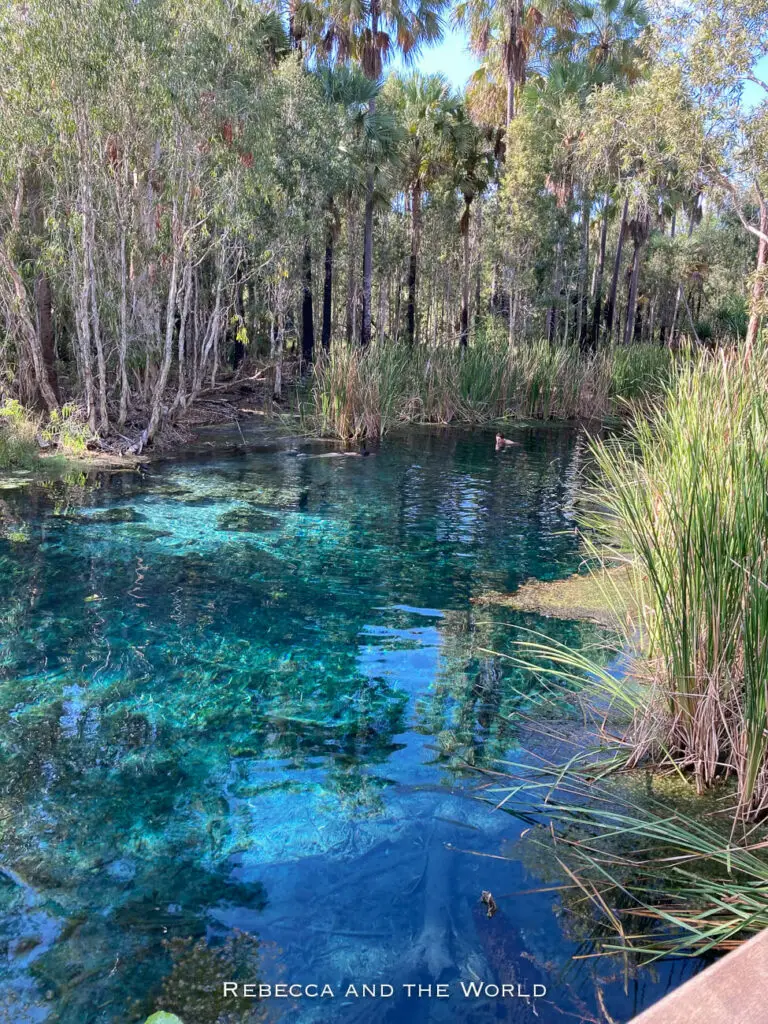
Distance from Daly Waters: 168km or 1 hr 45 mins
How many days here? 1-2 days
On your way to Mataranka, stop at Larrimah. This remote town is home to a pub and a giant pink panther statue (as well as a more recent podcast/book/documentary!), and is a good place to take a quick break.
When you reach Mataranka, you’ll notice that you’re leaving the arid desert and getting closer to the tropics. The air here is thicker and the plant life changes.
Mataranka is best known for its crystal clear thermal pools, located within Elsey National Park. Bitter Springs and Mataranka Springs are some of the best swimming spots in the Northern Territory. I recommend checking out both of them, as they’re quite different experiences.
Where to stay
There are several accommodation options in Mataranka, including camping and cabins.
The Territory Manor Motel & Caravan Park is just a short drive from both hot springs. It has a swimming pool and restaurant. Check rates on Expedia or Booking.com
Bitter Springs Cabins are very popular, with a range of cabins as well as a relaxed campground. It’s on the banks of the Littler Roper River.
Stop 12: Katherine
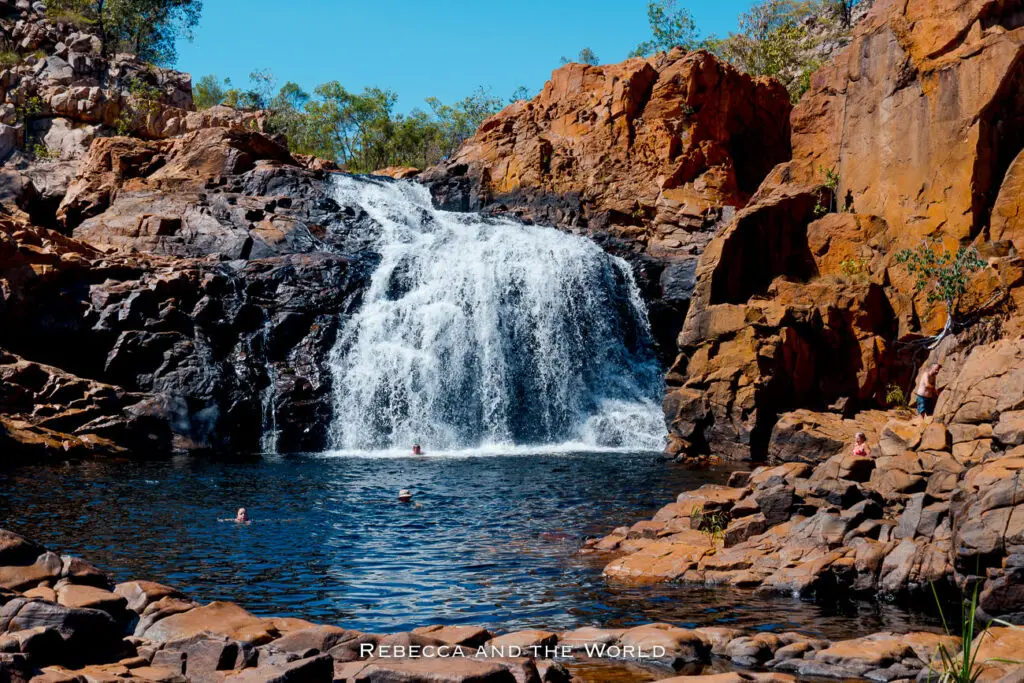
Distance from Mataranka: 108km or 1 hr
How many days here? 2-3 days
Katherine was one of our favourite towns on this Adelaide to Darwin road trip and one of my favourite places to visit in the NT. It’s a welcome break from the dry, dusty Outback, with plenty to keep you busy for a few days.
The highlight of a trip to Katherine is nearby Nitmiluk National Park (Katherine Gorge). Here you can go hiking, take a scenic cruise or hire a canoe to explore the gorge system.
You can’t miss the Leliyn (Edith Falls) section of Nitmiluk National Park. The swimming holes here are incredible. Take the 2.6km Leliyn Trail, a loop that takes you through monsoon forest and along the top of the waterfall before descending to a series of natural pools where you can swim.
I highly recommend adding on the longer Sweetwater Pool Walk if you’ve got the energy (6.8km return from the Leliyn Trail turnoff). Make sure you start early – we were on the trail at about 8am and had Sweetwater Pool to ourselves for about 15 minutes. It gets much busier as the day goes on.
Back in Katherine town itself, the Katherine Hot Springs are a must-visit – or do as we did and visit them every day! It’s incredible to have this little oasis right in the town. The water is warm and inviting, hovering around 25 to 30 degrees, and the springs are surrounded by lush greenery. And it’s free!
If you’re interested in history, the Katherine Museum has exhibitions on the region’s Indigenous culture and early settlers.
The Cutta Cutta Caves, about 30 minutes from town, are another interesting stop if you’re intrigued by the subterranean world.
READ NEXT: The Best Things to Do in Katherine, NT
Where to stay
We stayed at the Riverview Tourist Village in our camper trailer. We loved it so much that we ended up staying there for more than a week over two different visits! It’s right by the hot springs, so you can be first in when the gates open in the morning. There are cabins and caravan sites. Check rates online
Other great accommodation options in Katherine are:
- The Contour Hotel, set on four acres of tropical gardens. There are tennis courts, a swimming pool, restaurants, barbecue facilities and a bar. Check rates and availability on Booking.com or Expedia
- Knotts Crossing Resort – Close to the Katherine River, this resort has a range of accommodation options, from cabins to motel-style rooms. It also has a restaurant and swimming pool. Check rates and availability
Stop 13: Kakadu National Park
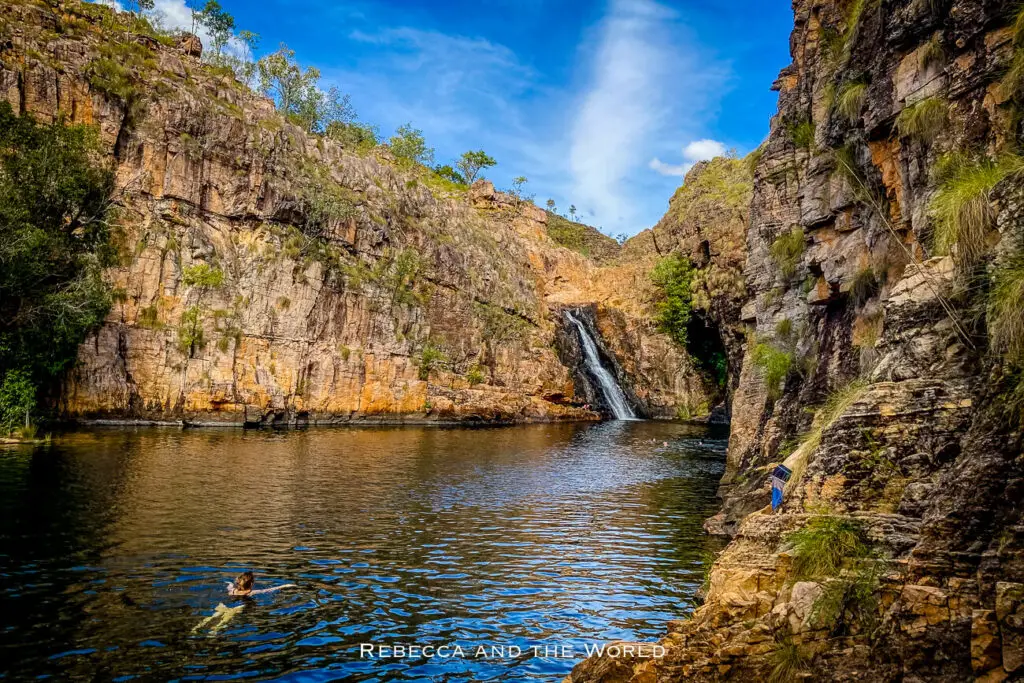
Distance from Katherine: 152km or 1.5 hours
How many days here? 3-5 days
Take another optional side trip off the Stuart Highway to one of Australia’s most iconic national parks, Kakadu.
As a World Heritage Site, Kakadu National Park is home to stunning natural landscapes, diverse wildlife and important cultural sites for the traditional owners of the land, the Bininj/Mungguy people.
To fully appreciate the park’s vastness and diversity, I recommended spending at least 3-5 days here. The park is huge and there are so many things to do here, from guided tours, boat cruises and hikes to explore the 7 different regions of the park.
One of the highlights is a visit to Ubirr, where you can see ancient rock art dating back thousands of years. The best time to visit is sunset for glowing views all the way across to Arnhem Land. Another must-see is Jim Jim Falls, one of the most photographed waterfalls in Australia (4WD access only).
There are only a handful of swimming holes in Kakadu, and if you’ve got a 4WD then head to Maguk, a beautiful swimming hole surrounded by towering cliffs.
To explore Kakadu’s diverse wildlife, take a guided boat tour with Yellow Water Cruises on the Yellow Water Billabong and the South Alligator River. These 1.5-hour tours depart throughout the day – but sunrise and sunset are best.
During the tour, you’ll see hundreds of birds, buffalo and other wildlife – as well as more crocs than you can count.
Where to stay
If you want to stay in Kakadu National Park, there are several campsites of varying quality and facilities. During our time in Kakadu, we stayed at Djarridjin, Mardukal and Maguk campgrounds. A full list of campgrounds can be found online.
If you’re not camping, I recommend the Mercure Kakadu Crocodile Hotel. Shaped like a crocodile, it is definitely a unique place to stay and also has a swimming pool and on-site restaurant. Check rates and availability online at Booking.com or Expedia
Further inside the national park is Cooinda Lodge, which has both camping and hotel options. It’s close to Yellow Water Billabong and has a restaurant and bar. Check rates online at Expedia or Booking.com
The national park is big, so you might find yourself swapping hotels/campsites throughout your trip so you can be closer to different parts of the park.
READ NEXT: 23 Must-Dos in Kakadu National Park + Itinerary Ideas
Stop 14: Litchfield National Park
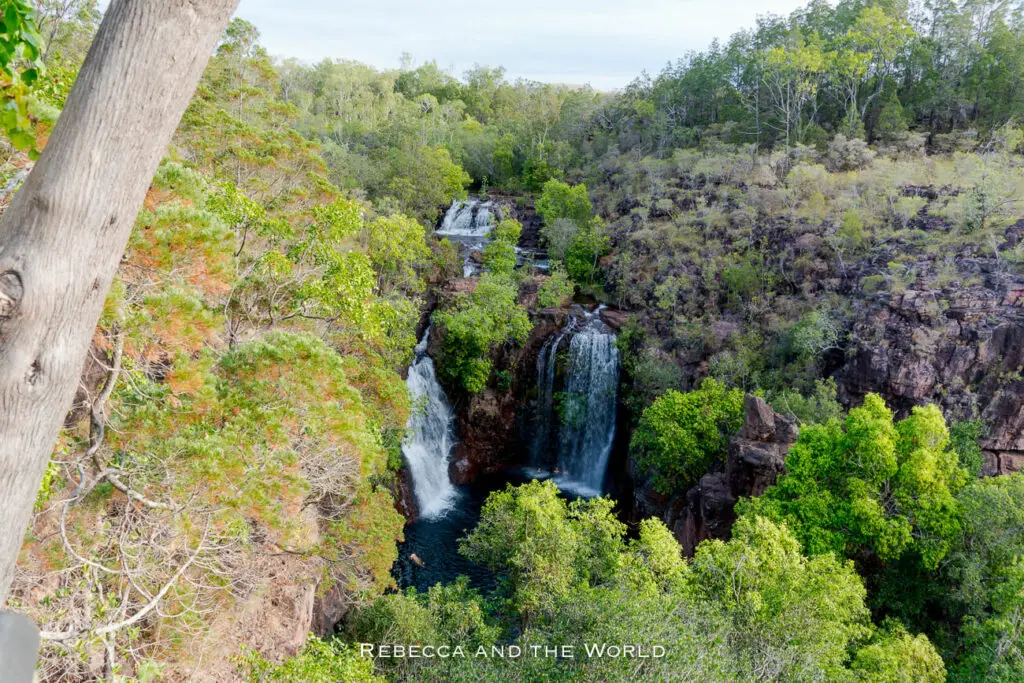
Distance from Kakadu National Park: 197km or 2 hours
How many days here? At least 2 days
Following up one epic national park with another, your next stop should be Litchfield National Park.
While it’s entirely feasible to visit here on a day trip once you’ve arrived in Darwin, this park deserves more of your time. With gorgeous waterfalls, refreshing swimming holes, a range of walking trails and thrilling 4WD tracks, it’s a great way to round out your Adelaide to Darwin drive.
Spend a few days hopping from swimming hole to waterfall to hike. The must-dos are Wangi Falls and Florence Falls, two incredible waterfalls with deliciously cool waters to swim in. These are some of the most popular waterfalls in Litchfield, however, so head to Upper Cascades and Tjaetaba Falls for some (relatively) quieter spots to wallow in.
Check out the “magnetic” termite mounds to see the impressive homes these busy little insects build for their queens.
If you’ve got a 4WD, check out the Lost City – reminiscent of an ancient Mayan ruins – or Surprise Creek Falls.
Where to stay
There are several camping areas right within Litchfield National Park. Popular spots include Florence Falls Campground and Wangi Falls Campground – you’ll need to book online in advance to get a spot.
For glamping, Litchfield Safari Camp is in a great location on the western side of the park, about a 10-minute drive from Wangi Falls – so you can be up early to get there before everyone else! Hideaway Litchfield has luxury cabins built from shipping containers, each named after a place in Litchfield.
There are also several caravan parks. We stayed at Litchfield Tourist Park, which has cabins and caravan/campsites. The caravan sites are generously sized and shaded. There are also cabins and even a 3-bedroom homestead for those travelling in a group. There’s a pool and cafe on site. It’s about a 45-minute drive to Wangi Falls from here. Check rates and availability online
READ NEXT: Everything You Need to Know about Visiting Litchfield National Park
Stop 15: Darwin
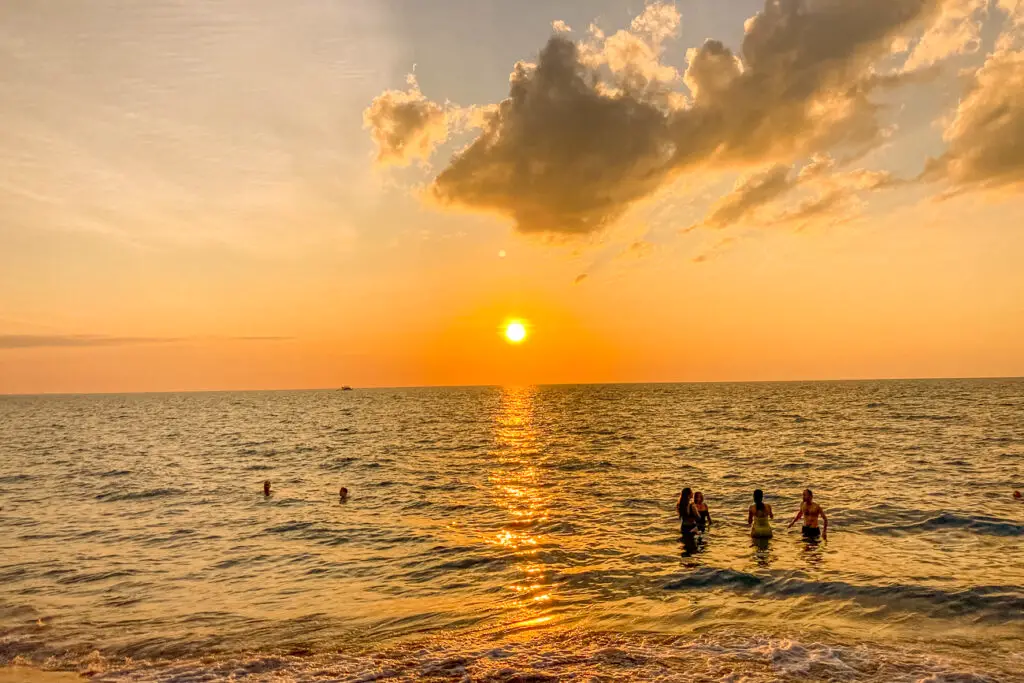
Distance from Litchfield National Park: 106km or 1 hr 15 mins
How many days here? At least 2 days
You’ve made it! After 3,000km through Australia’s Outback and the tiny, remote towns you’ve visited, you’ll be shocked at the “big city” vibe of Darwin. With a population of over 145,000 people, it’s definitely the largest city you’ve been to in a while.
One of the best things to do in Darwin is hit the markets. One must-visit spot is the Mindil Beach Sunset Markets. Held every Thursday and Sunday evening during the dry season (April to October), these markets are the perfect place to grab some delicious food, shop for unique souvenirs and watch the sun set over the beach.
Other great markets to visit while you’re in town are the Saturday Parap Markets for incredible food, and the weekend Rapid Creek Market, which is more of a local’s market.
Get up close and personal with crocodiles at Crocosaurus Cove – try the “Cage of Death” if you dare!
If you need to escape the heat, head to the Waterfront. Here you’ll find a protected lagoon and big wave park, as well as an inflatable obstacle course.
For some history and culture, check out the Museum and Art Gallery of the Northern Territory. It’s a great place to learn about Indigenous culture and art, as well as the history of Darwin – and it’s free!
The Darwin Military Museum is another great spot. Don’t miss the short video – complete with bomb sounds and lights – that explains the bombing of Darwin by Japanese forces in 1942.
For a chilled night out, I love Deckchair Cinema. Relax back in the comfy chairs and watch a flick outdoors, as geckos scrabble across the screen and bats fly overhead.
Where to stay
The DoubleTree by Hilton Hotel Esplanade has harbour views and an enormous pool. It’s only a short drive to the Mindil Beach Sunset Market. Check rates and availability on Expedia and Booking.com
Also in the Waterfront precinct, the Vibe Hotel Darwin Waterfront has modern rooms, many with water views. Check rates and availability on Expedia and Booking.com
For caravanners and campers, the Discovery Parks Darwin is the closest caravan park to the city centre. It has two pools and caravan sites and cabins. This is where we stayed and it was a great spot.
The Darwin FreeSpirit Resort is a bit further out from the city but gets a big thumbs-up for its resort-style pool and more modern cabins.
READ NEXT: 19 Fun Things to Do in Darwin: Australia’s Coolest Hottest Capital
Best time of year to drive the Stuart Highway
The best time to drive from Adelaide to Darwin is during the dry season, from May to October. This is when the weather will be most pleasant for driving and exploring. The temperatures will be cooler – although you can still expect days of 30 degrees or higher as you hit the tropics.
From November to April, this part of Australia can be dangerously hot. Temperatures can soar above 40 degrees and the humidity is intense. The wet season also brings cyclones and heavy rain, which can make driving difficult and even dangerous.
If you do choose to drive during the wet season, be sure to check road conditions before setting off. Some parts of the Stuart Highway may become impassable during this time.
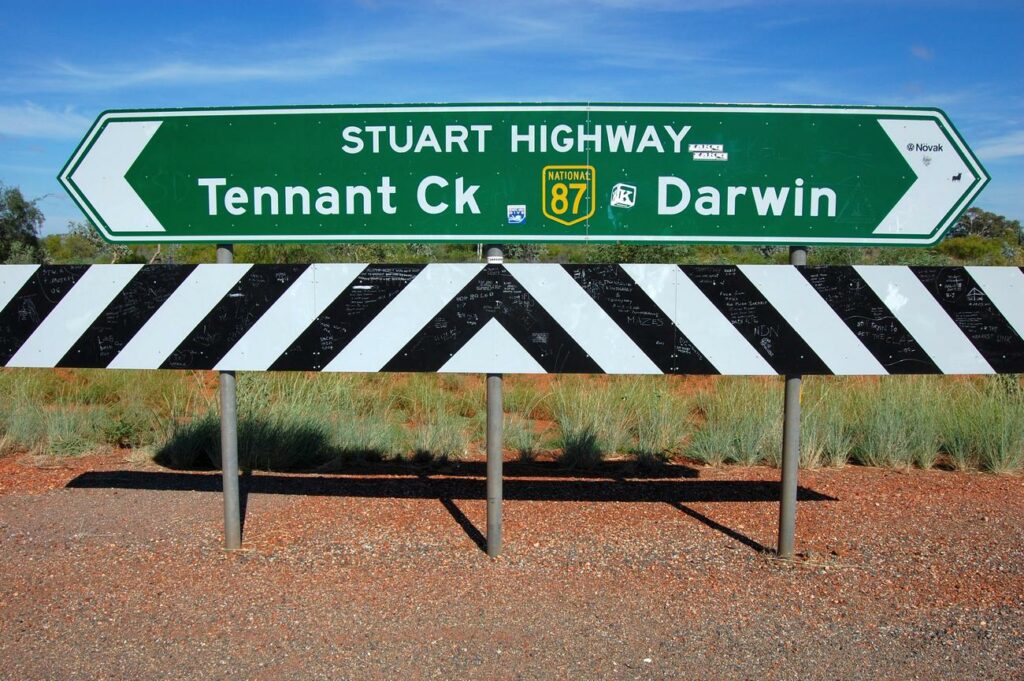
Stuart Highway road trip tips
First time driving the Stuart Highway? Here are some tips we picked up along the way.
Get your car checked first. Before you hit the road, make sure your car is in good condition. The Stuart Highway can be a remote and isolated drive, so it’s important to have a reliable vehicle. Get your oil changed, check the tyre pressure and make sure all of your lights are working.
Get roadside assistance. It’s always a good idea to have roadside assistance in case of emergencies.
Stock up on supplies. You’ll want to make sure you have plenty of food, water and other essentials for this remote journey – and be sure to stock up whenever you can. Adelaide and Port Augusta, Alice Springs and Katherine are the biggest towns along this drive and each has large supermarkets.
Fill up at every opportunity. Fuel stops can be few and far between on the Stuart Highway, so it’s important to fill up whenever you can. It’s a good idea to keep your tank at least half full at all times, just in case, and carry a jerry can.
Use an app to check fuel prices. We paid some pretty high prices for diesel along the highway. To save money, we used the PetrolSpy app to compare prices. It’ll also advise which roadhouses have petrol or diesel, and travellers regularly provide pricing/availability updates.
Take breaks regularly. Driving long distances can be exhausting, so make sure you take regular breaks along the way. Plan your stops ahead and take advantage of rest areas and roadhouses for a quick stretch. Download the WikiCamps app for rest stops (make sure you download maps offline so you can access them when you have no mobile coverage).
There’s little phone coverage. I was quite surprised at how limited mobile phone coverage was along the Stuart Highway. Except in towns and near major roadhouses, coverage was pretty spotty. Telstra is generally better than other networks. We had a CB radio as back up (also great to talk with other drivers/truck drivers about road conditions or giving someone a heads up when you’re about to overtake them).
Get a paper map. It’s hard to get lost on the Stuart Highway, but I do always like to have a physical map like this Hema map – especially when the mobile phone coverage is so patchy.
Give way to road trains. On the Stuart Highway, you’ll encounter lots of road trains – trucks pulling two or more trailers behind them. These vehicles are huge – some are almost 50 metres long! – and take up a lot of space on the road. Make sure to give way to them whenever possible – it can be dangerous to try and overtake them.
Don’t drive at night. Wildlife is abundant along the Stuart Highway, and driving at night greatly increases your chances of hitting an animal. Trust me, you’ll see the results all along the road. Not only is it dangerous for the animals, but it can also be a costly and potentially dangerous experience for you. Stick to driving during daylight hours.
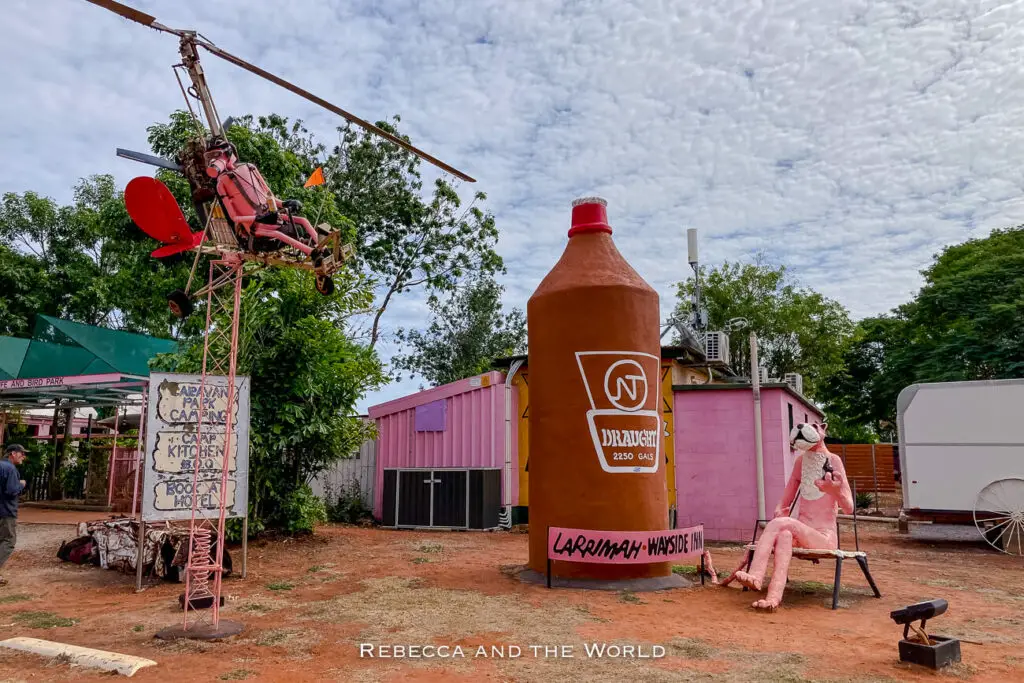
Final thoughts: Adelaide to Darwin road trip
The road trip from Adelaide to Darwin is an unforgettable experience. The Stuart Highway cuts right through the middle of Australia, showcasing an often unseen part of this incredible country. I absolutely loved the remoteness, the quirky characters and roadhouses, and the diversity of landscapes.
While it’s a once-in-a-lifetime journey, it’s something I actually want to do again!
Did you find this article helpful? Consider buying me a coffee as a way to say thanks!
Have you done the road trip from Adelaide to Darwin?
Related posts
Before you go… you might like these other Australia travel articles:
- A visitor’s guide to Ikara-Flinders Ranges National Park
- A guide to quirky Coober Pedy
- 19 spectacular things to do at Uluru
- How to spend a few days in Alice Springs
- The best things to do in Katherine, NT
- The best things to do in Nitmiluk National Park
- The ultimate guide to Litchfield National Park
- How to spend a few days in Kakadu National Park
- The best things to do in Darwin
- The best things to do in the Northern Territory
- The ultimate Australia bucket list
AUSTRALIA TRIP ESSENTIALS
- Book your flight to Australia online with Skyscanner. I like this site because it shows me which dates are cheaper.
- Find a great hotel in Australia. Check prices on Booking.com and Expedia online.
- Check out the huge range of day tours throughout Australia on GetYourGuide or Viator. There’s something for everyone.
- A copy of the Lonely Planet guide to Australia will be handy.
- One thing I always purchase is travel insurance! Travel Insurance Master allows you to compare across multiple policy providers, while SafetyWing is great for long-term travellers and digital nomads.
- Pack sunscreen (look for SPF50 or higher), a hat and sunglasses because the sun is hot!
PIN IT FOR LATER: ADELAIDE TO DARWIN ROAD TRIP
Save this guide to driving from Adelaide to Darwin to Pinterest for later!
